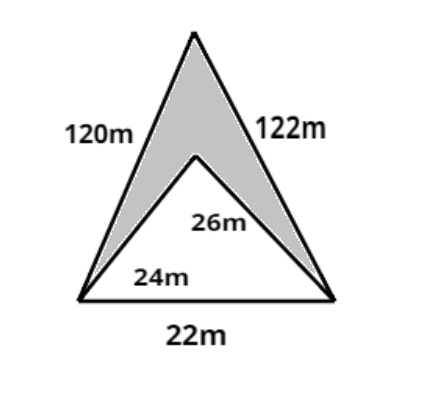
Calculate the area of the shaded region in the given figure.

$
(a){\text{ 1074}}{{\text{m}}^2} \\
(b){\text{ 1274}}{{\text{m}}^2} \\
(c){\text{ 1174}}{{\text{m}}^2} \\
(d){\text{ 1004}}{{\text{m}}^2} \\
$

Answer
517.2k+ views
Hint – In this question use the length of the sides given to compute the perimeter of the triangle, then using this perimeter compute the area of the triangles via formula $A = \sqrt {s\left( {s - a} \right)\left( {s - b} \right)\left( {s - c} \right)} $, where s is the perimeter. The required shaded area will be the area of the larger triangle subtracted with that of the smaller triangle.
Complete Step-by-Step solution:
As we know area (A) of triangle is
$ \Rightarrow A = \sqrt {s\left( {s - a} \right)\left( {s - b} \right)\left( {s - c} \right)} $
Where (s) is half of the perimeter and a, b and c are the sides of the triangle.
So the area (A1) of the bigger triangle is where a = 120m, b= 122m, c = 22m.
$ \Rightarrow s = \dfrac{{a + b + c}}{2} = \dfrac{{120 + 122 + 22}}{2} = 132$meter.
$ \Rightarrow {A_1} = \sqrt {132\left( {132 - 120} \right)\left( {132 - 122} \right)\left( {132 - 22} \right)} = \sqrt {132\left( {12} \right)\left( {10} \right)\left( {110} \right)} = \sqrt {132 \times 132 \times 100} = 1320{\text{ }}{{\text{m}}^2}$Now the area (A2) of the smaller triangle is where a = 24m, b = 26m, c = 22m.
$ \Rightarrow s = \dfrac{{a + b + c}}{2} = \dfrac{{24 + 26 + 22}}{2} = 36$meter.
$ \Rightarrow {A_2} = \sqrt {36\left( {36 - 24} \right)\left( {36 - 26} \right)\left( {36 - 22} \right)} = \sqrt {36\left( {12} \right)\left( {10} \right)\left( {14} \right)} = 245.92{\text{ }}{{\text{m}}^2}$
So the area (A) of the shaded region is the difference of area of bigger triangle and area of smaller triangle.
$ \Rightarrow A = {A_1} - {A_2}$
$ \Rightarrow A = 1320 - 245.92 = 1074.08 \simeq 1074{\text{ }}{{\text{m}}^2}$
So this is the required answer.
Hence option (A) is correct.
Note – In this question the perimeter is calculated using the sides as the perimeter is the sum of all sides, thus we have added all the sides. It is always advised to have a good understanding of the diagrammatic representation in the area problems as it helps figuring out the correct portion to whose area is to be calculated.
Complete Step-by-Step solution:
As we know area (A) of triangle is
$ \Rightarrow A = \sqrt {s\left( {s - a} \right)\left( {s - b} \right)\left( {s - c} \right)} $
Where (s) is half of the perimeter and a, b and c are the sides of the triangle.
So the area (A1) of the bigger triangle is where a = 120m, b= 122m, c = 22m.
$ \Rightarrow s = \dfrac{{a + b + c}}{2} = \dfrac{{120 + 122 + 22}}{2} = 132$meter.
$ \Rightarrow {A_1} = \sqrt {132\left( {132 - 120} \right)\left( {132 - 122} \right)\left( {132 - 22} \right)} = \sqrt {132\left( {12} \right)\left( {10} \right)\left( {110} \right)} = \sqrt {132 \times 132 \times 100} = 1320{\text{ }}{{\text{m}}^2}$Now the area (A2) of the smaller triangle is where a = 24m, b = 26m, c = 22m.
$ \Rightarrow s = \dfrac{{a + b + c}}{2} = \dfrac{{24 + 26 + 22}}{2} = 36$meter.
$ \Rightarrow {A_2} = \sqrt {36\left( {36 - 24} \right)\left( {36 - 26} \right)\left( {36 - 22} \right)} = \sqrt {36\left( {12} \right)\left( {10} \right)\left( {14} \right)} = 245.92{\text{ }}{{\text{m}}^2}$
So the area (A) of the shaded region is the difference of area of bigger triangle and area of smaller triangle.
$ \Rightarrow A = {A_1} - {A_2}$
$ \Rightarrow A = 1320 - 245.92 = 1074.08 \simeq 1074{\text{ }}{{\text{m}}^2}$
So this is the required answer.
Hence option (A) is correct.
Note – In this question the perimeter is calculated using the sides as the perimeter is the sum of all sides, thus we have added all the sides. It is always advised to have a good understanding of the diagrammatic representation in the area problems as it helps figuring out the correct portion to whose area is to be calculated.
Recently Updated Pages
Master Class 11 Accountancy: Engaging Questions & Answers for Success

Master Class 11 Science: Engaging Questions & Answers for Success

Master Class 11 Business Studies: Engaging Questions & Answers for Success

Master Class 11 English: Engaging Questions & Answers for Success

Master Class 11 Computer Science: Engaging Questions & Answers for Success

Master Class 9 General Knowledge: Engaging Questions & Answers for Success

Trending doubts
Why is there a time difference of about 5 hours between class 10 social science CBSE

What is the median of the first 10 natural numbers class 10 maths CBSE

The Equation xxx + 2 is Satisfied when x is Equal to Class 10 Maths

Write a letter to the principal requesting him to grant class 10 english CBSE

A Paragraph on Pollution in about 100-150 Words

State and prove the Pythagoras theorem-class-10-maths-CBSE




